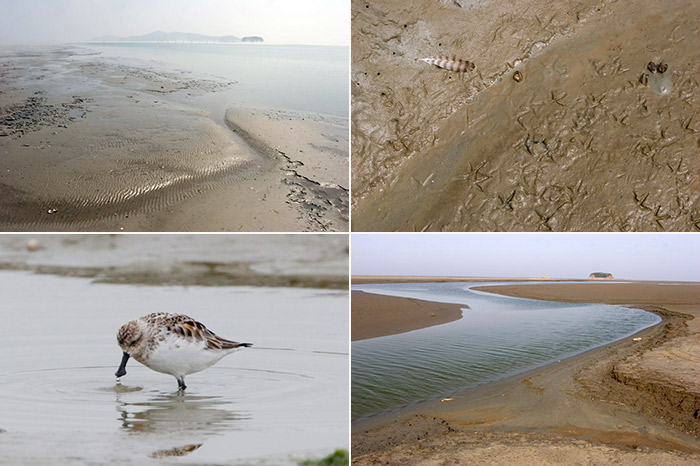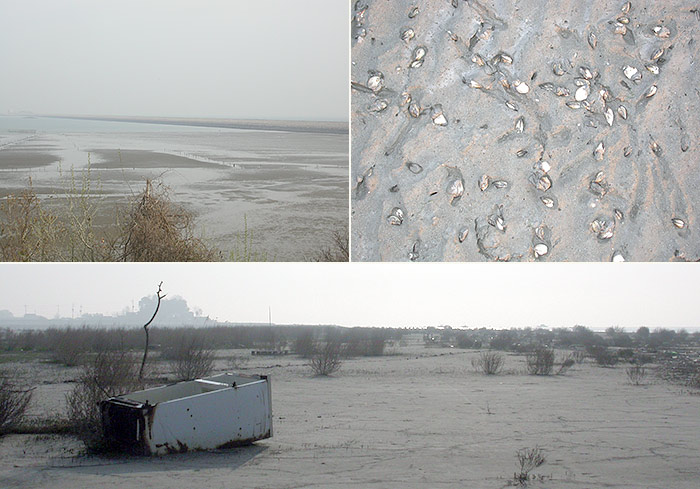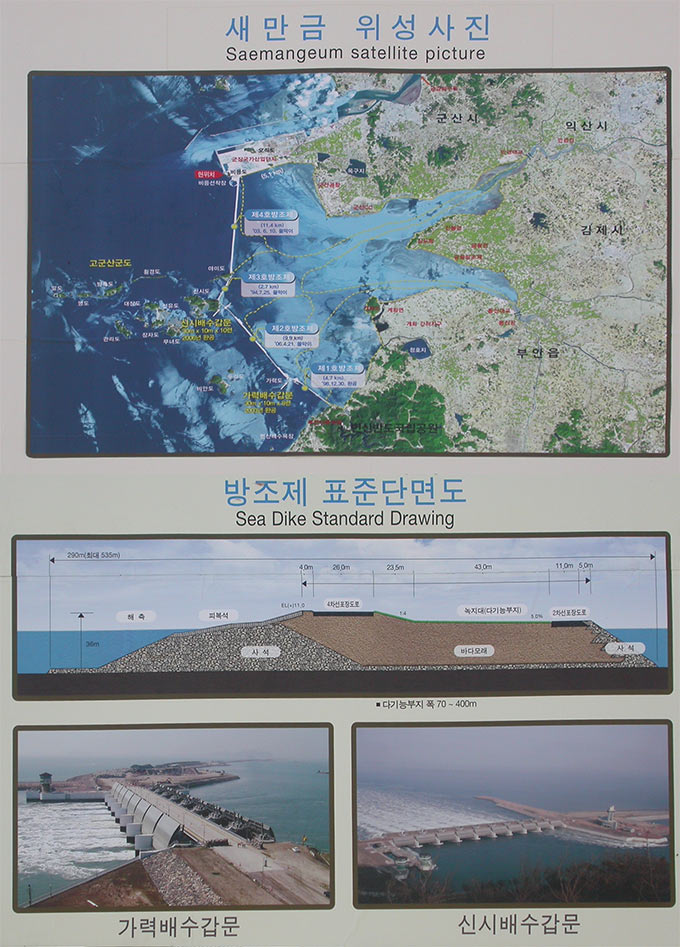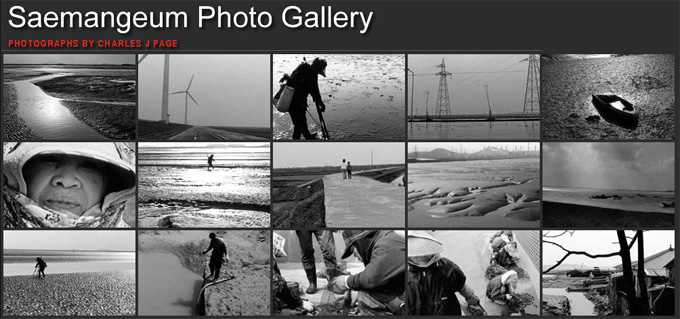Saemangeum Shorebird Monitoring Program (SSMP) 2006-2008
Saemangeum (pronounced "say-man-gum") is a 40 100 ha ongoing "reclamation" project in South Korea, entailing damming the estuaries of the Mangyeung and Dongjin Rivers, replacing vast bird-rich tidal-flats and sea-shallows with land and a huge freshwater reservoir, both still lacking any clear end use.
Started in 1991, the 33-km long seawall was finally completed on 21st April, 2006 It is the largest known project of its kind, destroying the single most important site for staging shorebirds in the whole of the Yellow Sea - itself a core area for migrant shorebirds of the East Asian/Australasian Flyway.
Saemangeum in April 2006 ...

Saemangeum in April 2007 ...

Saemangeum in April 2008 ...


Incredible as it seems, no open or clear program was in place to monitor the impacts on wildlife of this massive project - despite South Korea being a signatory to the Ramsar Convention, despite Ramsar Resolution 9.15 in 2005, recommending "the government of the Republic of Korea advise the Secretary General of the current situation concerning the sea-wall construction and reclamation of the Saemangeum coastal wetlands, and the impact of the construction work undertaken to date on the internationally important migratory waterbird populations dependent upon these wetlands" (Ramsar Res. 9.15.27.10).
Even more incredible, the major project proponents such as the Ministry of Agriculture and Forestry (MAF) and the Ministry of Construction and Transport have continued to insist that the reclamation is "environmentally friendly". The MAF even posted on their formal website in 2003 a long account defending the project, stating among other things that displaced shorebirds would move to the neighboring Geum Estuary and Gomso Bay; and that the reclamation area, like others made before it, would actually be good for the birds! (For a rebuttal by Birds Korea of these absurd claims, please go to MAFrebuttal) This was before their plans to reclaim the Geum Estuary as well were promoted once more.
As our response, Birds Korea initiated the Saemangeum Shorebird Monitoring Program (SSMP) in formal partnership with the international Australasian Wader Studies Group (AWSG), a specialist group of Birds Australia (Australia's partner to the global organization, Birdlife International).
The SSMP is a three-year program (2006-2008), entailing fieldwork (counting shorebirds, assessing habitat changes, and researching benthos during the northward shorebird migration period), dissemination of data gathered, and advocacy.

Update October 29 2009:
The negative cost of the Saemangeum reclamation (including water pollution, loss of livelihood, and a massive decline in shorebirds) were long predicted. The science remains clear. There is an urgent need to open the sea-gates fully and to restore tidal flow. In the spirit of the Changwon declaration (Ramsar resolution X.03) we urge all participants to this meeting (program see here) to “Stop our Wetlands from being Degraded and Lost!” and restore the Saemangeum estuarine system.
Update July 9 2009:
Professional photographer Professor Charles Page visited Saemangeum for four consecutive springs (2005-2008) with Birds Korea to document the conversion of East Asia's most important shorebird site into a wasteland.

To see the impacts of reclamation captured photographically:
http://www.saemangeumphotos.com/html pages/2005.htm
Update December 22 2008:
BirdLife International:
Report warns of shorebird extinctions
Update November 23 2008:
Reuters:
FEATURE-S.Korea builds city from sea at wetland's expense
Update October 26 2008:
Reuters:
South Korea land grab killing migratory birds
Update May 26 2008:
Fourth Count Cycle: May 20th-24th, 2008
Un mur sur la mer (A wall on the sea) - a c. 30 minutes documentary of the French Thalassa magazine about the Saemangeum reclamation project which was broadcasted on February 22nd 2008 by the French channel France3. To see the first 3 minutes scroll down and click on the image with the title: Un mur sur la mer.
Update May 15 2008:
Third Count Cycle: May 7th-12th, 2008
Update April 29 2008:
Second Count Cycle: April 18th-20th, 2008
Birdlife International April 16 2008
Shorebird staging-sites in short supply
Update April 10 2008:
First Count Cycle: April 4th-8th, 2008
Update March 2008:
First Update for Potential Overseas and English-speaking Participants. March 1st, 2008
Update October 2007:
Birds Korea - A Week in The Life And Death of Saemangeum
Update May 2007:
in press-release
To co-incide with World Migratory Bird Day 2007 the world-renowned UK charity The Royal Society for the Protection of Birds (RSPB) - one of whose staff, Sarah Dawkins, has been working with Birds Korea on the Saemangeum Shorebird Monitoring Program - has just posted a press-release about the Saemangeum reclamation on their website entitled "Wildlife starves on emptied wetland".
Written in consultation with Birds Korea's Director Nial Moores, the press-release clearly stresses the disastrous effect that the reclamation has already had, and inclues the following quote from Sarah Dawkins:
Saemangeum really was the jewel in the crown yet all around me the place is dying."
"Estuaries should be fantastic places, full of the bustle of shorebirds feeding on shellfish and worms in the mud and sand. The wall has blocked the life-giving ebb and flow of the sea, boats are stranded waiting for a tide that will never come and the mudflats are strewn with mile upon mile of litter.
Media coverage of Saemangeum following the RSPB's press-release was been gratifyingly extensive.
In the UK alone the following online reports/articles were noted on Saturday 14th May:
The Independent:
http://news.independent.co.uk/world/asia/article2533990.ece
The Times Online:
www.timesonline.co.uk/tol/news/uk/science/article1779606.ece
The Daily Telegraph website:
www.telegraph.co.uk/earth~earth/2007/05/12/eakorea12.xml
BBC Online:
- Lead story on BBC Online sci/nature page, the central to asia/pacific page and also on world page.
news.bbc.co.uk/1/hi/world/asia-pacific/6649233.stm - and in Spanish:
news.bbc.co.uk/hi/spanish~newsid_6649000/6649923.stm
Channel 4 News website:
www.channel4.com/news~wetlands+project+puts+birds+at+risk/
Also:
http://www.inthenews.co.uk
http://www.belfasttelegraph.co.uk
Additional to the online reports, several Birds Korea/SSMP members and senior RSPB staff members also recorded live radio interviews:
- Sarah Dawkins [RSPB/SSMP] recorded an overnight World Service programme
- Mark Avery [RSPB] recorded World Service news bulletins
- Nial Moores [Birds Korea/SSMP] spoke to BBC Five Live
- Sarah Dawkins [RSPB/SSMP] and Andre Farrar [RSPB] spoke to Sky News Radio.
Please support Birds Korea: your membership, donations, advice and participation really do make a difference!
Further background
Started in 1991, a 33 km long seawall built to cut both estuaries from the Yellow Sea was completed on 21 April, 2006. Further dyke-building, planned to start in 2008, will probably take another ten years to complete.
The Saemangeum "reclamation" project is believed the largest single coastal reclamation in the world, and remains hugely controversial. It has provoked some of the largest ever environmental protests inside Korea, and the most sustained international protests ever against a South Korean development project. Outer seawall construction was stopped several times due to these protests: to allow national courts to debate the legality of the "reclamation"; and to consider ways in which to reduce water pollution.
By 25 April, 2006, only four days after seawall closure, shellfish beds in the enclosed area started to die. By the end of May, most were dead, and water quality was already deteriorating rapidly. 90% of Saemangeum's vast tidal-flats are now expected to be lost by 2007, either dried out or permanently flooded. Water pollution is expected to worsen dramatically. The area had enormous local and national importance for fisheries, supporting the livelihoods of an estimated 25 000 people.
Internationally, the natural Saemangeum system was the single most important shorebird staging area in the Yellow Sea, itself a core part of the East Asian Australasian Flyway. At least 18 species of shorebird and 9 other species of waterbird were supported by the area in internationally important concentrations.
- Key species included the Endangered Spoon-billed Sandpiper (highest counts of over 200), the Endangered Nordmann's Greenshank (over 60) and the Great Knot, the latter with a peak count of over 125 000: 30% of the world's population.
- Probably over 300 000 shorebirds depended on the Saemangeum estuarine system annually.
Birds Korea and the specialist Australasian Wader Studies Group launched the Saemangeum Shorebird Monitoring Program (SSMP) in spring 2006, to monitor and publicise the impacts of this reclamation.
The completed Report is online and available for download (for Preliminary Data from the survey go to SSMP: Preliminary data):
|
|
|
Recent Related Articles:
- Shorebirds: Towards their Conservation in South Korea. Nial Moores. July 2006.
Archived Saemangeum Campaign News:
- Campaign news from 2003
- Campaign news from 2004
- Campaign news from 2005
- Campaign news from 2006 - and announcement that the seawall has been completed
Yellow Sea/Saemangeum(-related) Reports etc:
- Korean Wetlands Alliance (Edited by N.Moores) 1999. Internationally important wetlands especially as waterfowl habitat. National NGO Wetlands Report: Ramsar 1999.
- Moores, N. et al. (a 2001) Yellow Sea Ecoregion: Reconnaissance Report on Identification of Important Wetland and Marine Areas for Biodiversity. Volume 2: South Korea. Joint publication of WWF-Japan, Wetlands & Birds Korea, and Wetlands International China Program
- Moores, N. (b 2001) Internationally Significant Wetlands to be 100% Reclaimed. WWF Arctic Bulletin, No. 3.01, pp. 12-13.
- Moores, N. 1999. A survey of the distribution and abundance of shorebirds in South Korea during 1998-1999. Stilt 34: 18-29.
- Asia-Pacific Migratory Waterbird Conservation Committee (2001) Asia-Pacific Migratory Waterbird Conservation Strategy: 2001-2005. Wetlands International- Asia Pacific. Kuala Lumpur, Malaysia.
- Barter, M.A. 2002. Shorebirds and The Yellow Sea: Importance, threats and conservation status. Wetlands International Global Series 9, International Wader Studies 12, Canberra, Australia.
- Perennou, C.P., Mundkur, T., and Scott, D.A. 1994 The Asian Waterfowl Census 1987-1991: distribution and status of Asian waterfowl.IWRB spec. Publ. No. 86. Slimbridge, UK and Kuala Lumpur, Malaysia.
- Wells, D.R. and Mundkur, T. (eds) 1996. Conservation of Migratory Waterbirds and their Wetland Habitats in the East Asian-Australasian Flyway. Proceedings of an International Workshop, Kushiro, Japan. 28 Nov-3 Dec 1994. Wetlands International-Asia Pacific, Kuala Lumpur, Publication No.116, and International Waterfowl and Wetlands Research Bureau-Japan Committee.
- Lighthouse Foundation: FASS - For a Sustainable Saemangeum
Bird Species threatened by Saemangeum:
External links:
- Red Data Book Asia
- www.ea.gov.au/water/wetlands/mwp/yellow-sea.html - link to Mark Barter's Yellow Sea report on Environment Australia.
- Black-faced Spoonbill Website (in English)
Black-faced Spoonbill Website (in Chinese) - Black-faced Spoonbill Conservation (English/Japanese - PDF format)
- Asia faces Bird Extinction Crisis - article on Surfbirds.com
- ThaiWaterbirds.com article on Spoon-billed Sandpiper (in Thai).
- National Geographic.com short article on Great Knot migration.
Wetland/Shorebird Conservation Organisations:
- Ramsar
- Wetlands International
- Wildfowl and Wetlands Trust
- Australasian Waders Study Group
- The Royal Forest and Bird Protection Society of New Zealand
- Birds Australia
- BirdLife International
- World Wildlife Fund
- International Wader Study Group
- Oriental Bird Club
- Taiwan Wader Study Group (in Chinese)
- Anatidae Site Network in the East Asian Flyway
- Manomet Center (USA)
- U.S. Shorebird Conservation Plan - Related Programs




 Diese Seite in Deutsch
Diese Seite in Deutsch

